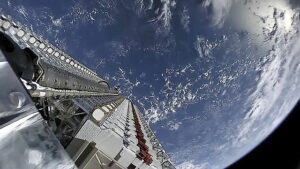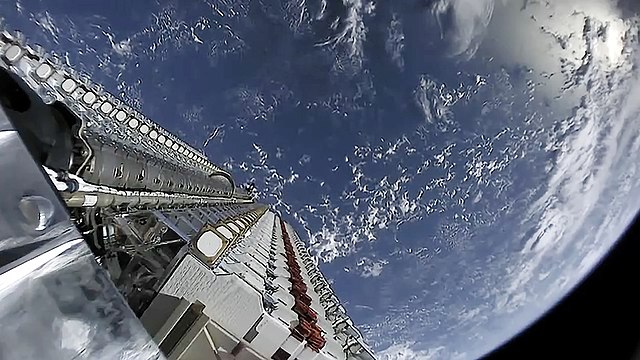After years of planning and hype, the Starlink project is finally being launched.
Starlink and its founder, Elon Musk, claim that it will revolutionize the internet. The project is based around a megaconstellation of low-Earth orbit satellites which can, through radio signal, beam high-speed internet down to Earth.
The strategy and technology behind Starlink Internet are wildly unique. Up until a few years ago, internet access could only be provided by one thing: broadband cables under the ground. To urban communities, which have access to many broadband internet providers, this is hardly an issue. However, to rural communities with only one or even zero internet providers, broadband can be slow, overpriced and restrictive.
The satellites of Starlink are here to change that through providing radio-transmitted internet connections to just about everywhere on the planet (except the North and South Poles).
There are other companies working in the same sphere of satellite internet, notably Hughesnet and Amazon’s Project Kuiper. However, Starlink claims to offer advantages over the competition such as operating their satellites closer to Earth, thereby providing a stronger, faster connection.
Internet inequality has persisted for years, and the pandemic has heightened the need for a solution. In 2019, 45% of households in the world did not have internet access according to UNESCO.
Not having access to the internet meant that your education and personal life were severely limited. During the pandemic, students across the country attended classes on their computers, and family reunions were accessed through Zoom links. The internet has been the lifeline for the quarantine lifestyle — there’s just no way around it.
Starlink, it seems, is a dream come true.
Unfortunately, though, we live in an age in which billionaires’ personal fantasies are disguised as humanitarian causes. Often, sensational technology quickly dissolves into a problem once you interrogate its effects. Musk’s Starlink is no different.
Delivering high-speed internet to rural populations is certainly commendable. But, at least for the foreseeable future, Starlink has failed in this mission. With a start-up fee for a user of $599 and a monthly fee of $99, the technology is simply too expensive to be accessible for a low-income and underserved population.
Thus, it is clear that Musk’s objective is not to provide internet access to the most vulnerable in our society. The novelty of Starlink seems to be the true motivator.
To be fair, the image of an army of satellites whizzing across the upper atmosphere and emitting internet connection down to the masses is certainly striking. However, when that futuristic new technology fails to deliver on its most basic promises, the time comes to reevaluate its effectiveness.
The unreasonable price tag is just the tip of the iceberg. Starlink’s finalized plans, which have been approved by the U.S. Federal Communications Commission, involve placing as many as 42,000 satellites into low-Earth orbit. To put that into context, the European Space Agency estimates that there have been less than 13,000 satellites ever launched in human history. Not surprisingly, all that new metal carelessly orbiting the planet is going to have dangerous consequences.

photos courtesy of Wikimedia Commons
All satellites reflect a considerable amount of sunlight. This phenomenon causes a brightened atmosphere and makes it difficult for astronomers to image distant celestial objects.
Satellites brightening the night sky has been a well-known effect for some time, but it has not been much of a problem with the small number of satellites currently in orbit. Putting thousands and thousands of new Starlink satellites into orbit, though, will certainly have an effect. An October 2021 report from the American Astronomical Society claimed that Starlink’s satellites could brighten the night sky “by a factor of two to three,” a level so great that it will certainly inhibit research about our universe.
Musk has only launched 1,900 satellites of 42,000 planned, and yet their satellite flare has already begun ruining astronomical experiments.
For example, scientists at the Large Synoptic Survey Telescope (LSST) in Chile, have been engaged in a decade-long experiment to image the night sky in order to observe how the universe changes. Their work has been ruined by Starlink satellite flares.
According to Samantha Lawler, an assistant professor of astronomy at the University of Regina in Canada, satellite flare has caused a much larger problem than scientists initially expected.
“For the first time in human history, we’re not going to have access to the night sky in the way that we’ve seen it,” she said in an interview with CNN.
Because of large resistance from the astronomy community, Starlink is well aware of the problems that their satellites’ flare will cause. They have proposed two solutions. First, they will paint each satellite with an absorbent black paint so that they will reflect less light. This idea, only a semi-solution, has actually demonstrated a measure of success in reducing satellite flare.
Second, Starlink will steer their broken satellites back to Earth where they will burn up in the atmosphere. According to Musk, this process will minimize the number of satellites in orbit and therefore the light pollution. If this steering idea is used, though, another problem could be created. Burning massive amounts of metal in the upper atmosphere will almost certainly have unforeseen effects on the environment.
Starlink satellites contain large amounts of aluminum, and burning aluminum in the atmosphere could be especially dangerous. Via Aaron Boley’s 2021 report in Scientific Reports, high concentrations of aluminum in the upper atmosphere, an “otherwise pristine area,” could drastically increase Earth’s ability to reflect heat, thereby cooling the planet.
We currently do not know what the effects of Starlink could be on our planet. Sure, it is always possible that Starlink could only negligibly change the environment. But, that is the same mentality that scientists had about satellite flare, and that problem has gone on to fundamentally change our capacity to observe the universe.
Many consider these concerns to be irrelevant when considering the benefit that Starlink has given people. For example, Musk recently activated Starlink over Ukraine, an effort which gives civilians internet connection and access to information that will protect them.
This is Starlink’s most redeeming quality — its capacity for aid, for supporting humanity.
The system is far from perfect: Starlink users in Ukraine must always be wary of their routers alerting enemies to their location. The routers are big and bright white, and they must be placed on the users’ roofs to ensure proper contact with the satellites. Many Ukrainians have expressed fear that placing Starlink routers — designed by an eccentric billionaire with little regard for covertness or modesty — in plain sight could endanger them.

photos courtesy of Wikimedia Commons
When routers are placed away from people and adorned with light camouflage, as Musk advises, Starlink has provided tangible help to Ukrainian citizens. Information means survival in a warzone. In order to stay alive, every citizen must know when it is safe to leave the house, or when it is necessary to shelter. In providing internet connection, Starlink allows Ukrainian citizens to stay connected to family members and government agencies. Starlink allows Ukrainians to survive.
Starlink occupies a moral gray area. Its possibility to damage the environment and its steep, inaccessible price tag are certainly downsides, but its ability to provide aid cannot be overlooked.
The idea behind Starlink is certainly ingenious. Satellite-based internet very well could be the future, considering how widespread internet inequality has proved to be. But, the execution of that brilliant idea, the disregard for the environment and its target demographic, has been inadequate.
Perhaps in the hands of someone else, Starlink could be effective. After all, the project’s founder recently became the first person in recorded history to be worth $300 billion.
Additionally, on April 25th, it was announced that Musk’s astronomically-high bid to buy Twitter was approved, and that he will soon become the new owner. This transaction puts Musk at the head of yet another massively important technology company.
Musk is unfathomably rich and powerful. Is he really the right person to spearhead a project meant to benefit the underserved? Is it right that one person, just as human as you or me, can decide to change the night sky?
Starlink is certainly a flawed company. But, Musk’s decision to help Ukrainian citizens shows that Starlink can, indeed, aid the vulnerable. When Musk is motivated for the right reasons, Starlink can be used for good.






